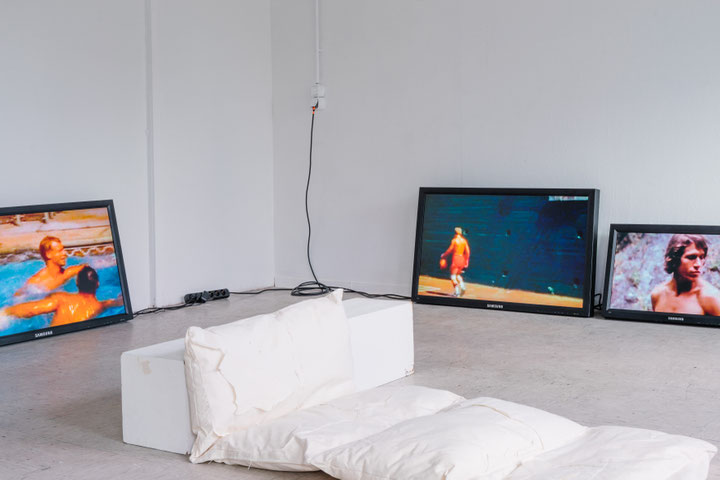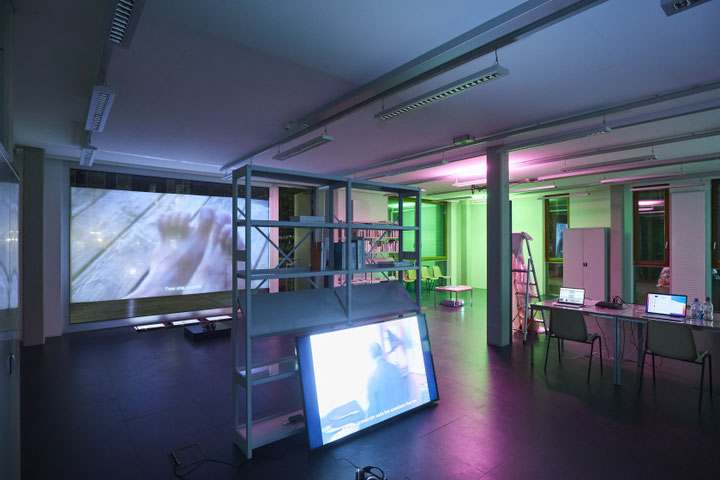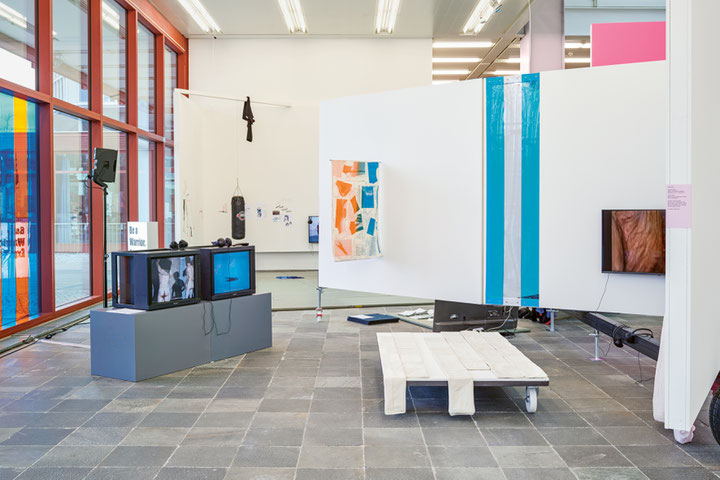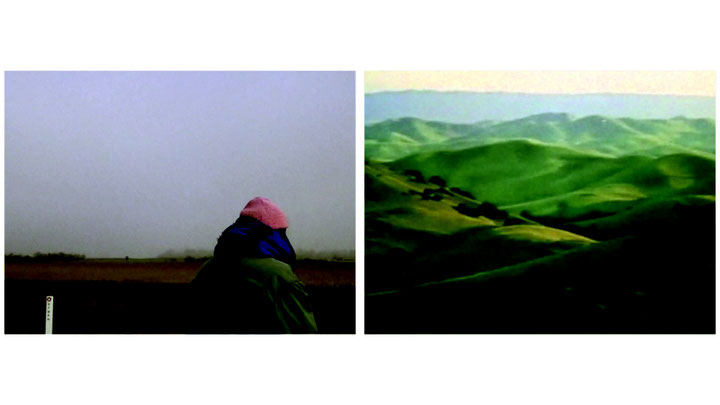We, this text’s authors, are a Vienna-based duo of researching artists, collaborating since mid-2020 on several projects that orbit topically around two overlapping strands: “archives” and “wormholes.” The first is the focus of “W/ri/gh/ting Archives through Artistic Research,” in which we engage, through a series of collaborations with researching artists and institutions, with archive-related practices within artistic research, with the intention of grasping and reflecting on theoretical, practical, and ethical issues that arise from such practices.1 The second points to a trope and a practice, around which we have generated a series of exhibitions, stage performances, and filmwork (to which we refer as Wormholes throughout this text), where we negotiate ways in which cinematic engagement with time may be disrupted through thinking of film language (editing, in particular) as a time-and-space travel technology.2 The overarching agenda of both projects lies in exploring modalities of collaborative multi-media processuality, oriented around social justice issues, which manifest themselves in and through archives. We engage with the latter by applying and designing artistic-research methods aiming to “exhaust” images, thoughts, and situations by repeating artistic gestures: of editing film, of sewing textile, of drawing, of translating them to different media.
In this text, we reflect on several overlaps between both projects. One of them pertains to the ways in which we delimit the term “archive,” which, as Julietta Singh quips, may mean “almost anything”: from “a physical place where a collection of documents is housed” to “a body of literature … a series of monuments, or a collection of images,” to anything that one studies and decides to call an “archive” for the purpose of granting it “the status of an intellectual pursuit.”3 Wormholes demonstrates our approach to film archives, where the medium of film shape-shifts into various forms and formats: a performative sound sculpture, an immersive room installation, a strategy of critical reading. In this way, we re-direct the immediate attention that we tend to give to the visual image toward other diegetic and non-diegetic film elements. Displayed on multiple screens, in orchestrated dialogue or out of sync with sound, our filmwork demonstrates the strategy of remixing, i.e. one that generates self-standing audiovisual content out of multiple samples of sound, text, and film, both found and made. In this way, we build fragmented and changeable narrative shapes for temporally-troubled spaces of in-betweenness, as regards media, contexts, genres, and presentation methods. The most recent example of this strategy is a two-channel film installation Time Flies … Temporalities Crumble, which combines footage that we shot with samples from over a hundred films from a few sprawling contexts, such as pre-AIDS gay-art porn films and sci-fi films of the Cold War era, made in the US, the former Eastern-Bloc states, and Japan. In this way, we create a fragmented conversation between multiple converging time-spaces, diegetic and non-diegetic. The resulting miniature narratives are anchored by the collage soundtrack, which mixes the original tracks by Seth Weiner & Sadie Siegel4 with field recordings, storytelling fragments, samples from audio tracks, and ambient sound recorded during our working sessions. The soundtrack, in turn, dialogues with the screening’s material setting, composed out of textile artworks: quilted screens and sitting cushions with embroidered patterns referencing images from our filmwork. While the screens highlight the way images are constructed, thereby offering the viewer visual tools with which to desiccate the image’s composition, the cushions invite them to comfortably linger, which is a quality that we cherish and frequently miss in how time-based media is presented in contemporary art spaces.5
Both projects think of archives in sprawling ways. They can be material and ephemeral, institutional and private. They can be repositories that store traces of colonial and imperial violence, that (mis)represent the cultural knowledge production of marginalized individuals and communities. We are interested in the complex temporality that archives share. Jacques Derrida describes it as one that affirms the present through preserving records of the past and, therefore, embodying a promise of a future.6 This promise is, however, troubled by an underlying suspicion of violence, stemming from the exercise and externalization of “authoritative law,” which the gesture of archiving entails.7 Violence, both within archives and of archiving, underlies a slew of our references to theory and artistic-research practices. The first group includes texts by critical archive studies researchers: Jamie Ann Lee, Michelle Caswell, Ricardo Punzalan, and T-Kay Sangwand. The second has projects like Tahani Nadim’s “bureau for troubles” (an ongoing archive-intervention into Naturkundemuseum Berlin’s collection), Belinda Kazeem-Kamiński’s films Unearthing. In Conversation (2017) and The Letter (2019), and Benny Nemer’s Audio Guides (ongoing since 2013). We address this violence through our project’s key operational term: “w/ri/ghting.” It is an amalgam of a trifecta of phrases: “wronging the wrongs,” “righting the wrongs,” “writing the wrongs,” proposed by Eve Tuck and C. Ree (2013) in their formally experimental glossary about decolonial autoethnographic practices within transdisciplinary social sciences, mainstream cinema, visual arts, and literary fiction.8 Dwelling on the possibility of social justice, the authors recognize its multi-layered relationship to “revenge,” i.e. “a form of double-wronging,” which derives its toxic potency from the realization that “righting wrongs” happens so rarely and that some “crimes … are too wrong to right.”9
Tuck and Ree's specifically situated reading of the impossibility of social justice informs our objective of generating “counter-memory” through archive-oriented work. For Hal Foster, this constitutes the agency of archiving.10 We perform this intention by applying artistic-research methods of “queering,” which derive from three theoretical formulations: “critical fabulation,” “disidentification,” and “critical cartography.” The first, proposed by Saidiya Hartman, is a mode of speculative writing that recombines elements of received accounts and displaces the elements and “constitutive limits” of the North-Atlantic slavery archive.11 The author employs Mieke Bal’s description of “fabula” as “a series of logically and chronologically related events that are caused or experienced by actors,” constructed “according to certain rules.” Fabulations are “folds” within fabulas, “fabulous fictions of presence that flaunt their fictionality.“12 We employ critical fabulation in the ways we engage our references: by relying on archival film material and by negotiating the limits of academic writing. Fabulating is causally related to disidentification, a strategy that José Esteban Muñoz describes as “read[ing] … [one’s] life narrative in a moment, object, or subject that is not culturally coded to ‘connect’ with the disidentifying subject”; the latter expresses the ideology of the “phobic majoritarian public sphere.”13 By adopting both methods, we recycle, rethink, and remix the encoded messages in our references (text-based, found-footage and original audiovisual material) with the agenda of “resist[ing] and confound[ing] socially prescriptive patterns of identification.”14 While being aware of the original contexts of such references, we abstract and situate them in recombined heterogeneous “elsewheres,” which intersect in our text- and film-based work. The third term relates to “dynamic zigzagging,” i.e. how we navigate through and across our references. Critical cartography contests the exigency of linearity, which cannot exhaustively describe the “web-like, scattered and poly-centered” ways in which contemporary science and global economy function.15 It is a form of generative disorientation, whose agenda rhymes with Muñoz's description of “cruising”: a dis/orienting “modality of inquiry,” fashioned upon the practice of searching for sexual encounters in public spaces.16 When applied to intellectual inquiry, it expresses an openness to semantically unstable categories and the liminal spaces they invite.
The above three terms are central to the methodology that became our starting position in both projects. In Wormholes, it helped us conceptualize its central keyword in rhizomatically literal and figurative ways. Wormholes are many things-in-becoming, from a literal hole in wood or fruit, in the process of being burrowed by worm-like creatures, to a figurative hole, such as a productive digression in a conversation, which is both a detour and a destination in-the-making, to the way of navigating digital space, of endlessly browsing internet pages by way of embedded hyperlinks. Inspired by their temporality, we started generating wormhole-shaped and -temporal material objects, film installations, and trains of thought, turning the trope of outer-space time-travel into a film-making screening-installation strategy. In the sci-fi films that we watched while conceptualizing the project, we were rarely offered insight as to what undergoing a journey through a wormhole may feel like.17 We kept searching for manifestations of more complex wormhole temporalities, ones that would pay more attention to the laborious process of moving through them, despite the speed-of-light velocity at which this happens, as sci-fi productions tend to imply. We came across dozens of films from the 1950s–1970s, paced more slowly so as to make time for lingering images of blinking flying saucers, pensive astronauts, confused space monsters, and leisurely-paced tarantulas, all of which are easily abstracted from their otherwise linear plots. We started noticing similar pacing elsewhere, e.g. in the US-based pre-AIDS gay-art porn films, where non-sexually explicit scenes are given more narrative and aesthetic agency than the hasty exposition scenes in later-year gay-porn films, which provide a perfunctory padding on the way toward climactic-by-default cum-shot scene conclusions.
One key to thinking of how our projects meet pertains to “the erotic,” as described by Audre Lorde. At the inception of both projects, it was not our methodology-building keyword, yet it gradually seeped through how we came to think of the many archives that we interact with.18 Lorde juxtaposes eroticism with pornography, which she describes as “sensation without feeling”; the erotic stands for “the personification of love in all its aspects,” an assertion of the lifeforce of women.”19 Though her description is more vaguely figurative than descriptive, she demonstrates a habit of dichotomizing pornography and eroticism along the lines of separating “the spiritual (psychic and emotional) from the political,” thereby seeing them as antithetical.20 The pre-AIDS gay-art porn films are demonstrative of the convergence of both phenomena, as they open sex-centric plots to unpredictable moments of narrative errantry, while showing their characters perform daily-routine activity, such as walking dogs, cooking breakfast eggs, taking showers, or sitting around and chatting. While contributing to the films’ portrayal of erotic bliss, they also normalize non-normative sexual activity through manifesting the quotidian quality of explicitly pornographic sexual encounters despite the fact that “homosexual acts” in the US only started to be decriminalized.21 While both of us are currently based in Vienna, a relatively safe and unintrusive space for queer-presenting people, we still experience moments of homophobic” violence (verbal, most often), which harkens back to our pasts. Thinking of “queer futures,” ones where everyone could unconditionally enjoy their basic human rights, is a politically significant impetus for us, born and raised in Brazil and Poland, i.e. two nation states with long histories of complicated and violent sexual politics, informed by the homophobic, sexist, and anti-wom*n discourses, cultivated by the Catholic fanatic-religion-heavy right-wing state policies. While not all the source material that we invite to our practice as references discusses queer matters or is authored by queer-identifying artists and theorists, it nevertheless presents us with room to fabulate sprawling and ephemeral forms of what such queer futures could be like.
1 The project “W/ri/gh/ting Archives through Artistic Research” is funded by Österreichischer Wissenschaftsfonds FWF (AR716), and hosted at the Academy of Fine Arts Vienna. For more information on the project and its updates, see: https://wrighting-archives.com/
2 Another important context is women-made and women-centric “avantgarde” and arthouse films of the 1960s–1980s, which will come to the fore in the project’s future iterations. For more information, see: https://www.maggessi-morusiewicz.com
3 Julietta Singh, No Archive Will Restore You. Goleta 2018, pp. 22–23.
4 For more information about Seth Weiner’s projects, including Sadie Siegel, see: https://sethweiner.org
5 The work Time Flies … Temporalities Crumble was shown in the exhibition “About the New. Viennese Scenes and beyond” at Belvedere 21 (06.04–02.07.2023). For more information, see the exhibition catalogue.
6 Jacques Derrida, Archive Fever: A Freudian Impression, Diacritics 25, no. 2 (1995): pp. 9–63, p. 17.
7 Singh, 2018, p. 24.
8 Eve Tuck and C. Ree, “ Glossary of Haunting, in: Handbook of Autoethnography, Stacey Holman Jones, Tony E. Adams, and Carolyn Ellis (Eds.), California 2013, pp. 639–658. p. 654.
9 Ibid.
10 Hal Foster, An Archival Impulse. October, no. 110 (2004): pp. 3–22, p. 4.
11 Saidiya Hartman, Venus in Two Acts, Small Axe 12, no. 2 (2008): pp. 1–14, p. 11.
12 Mieke Bal, Narratology: Introduction to the Theory of Narrative (3rd edition). Toronto 2009, pp. 5–7; Mieke Bal, Traveling Concepts in the Humanities: A Rough Guide. Toronto 2002, pp. 88–89.
13 José Esteban Muñoz, “Introduction: Performing Disidentifications.” In Disidentifications. Queers of Color and the Performance of Politics, 1–34. Minneapolis 1999, p. 12.
14 Ibid., p. 28.
15 Rosi Braidotti, The Posthuman. Cambridge 2013, pp. 164–165.
16 José Esteban Muñoz, Cruising Utopia. The Then and There of Queer Futurity. New York 2009, p. 18.
17 Time-traveling through such portals is the narrative device in Event Horizon (dir. Paul W. S. Anderson, 1997), The Black Hole (dir. Gary Nelson, 1979), Inquest of Pilot Pirx (dir. Marek Piestrak, 1979), and TV series Stargate SG-1 (created by Brad Wright & Jonathan Glassner, 1997–2007). The arduous process of such travels is depicted in La jetée (dir. Chris Marker, 1962) and Altered States (dir. Ken Russell, 1980), which show their protagonists in physical and mental distress while undergoing time-bending journeys.
18 Audre Lorde, “Uses of the Erotic: The Erotic as Power,” in Sister Outsider: Essays and Speeches, Berkeley 2007, pp. 53-60, here: pp. 54–56.
19 Ibid.
20 Ibid., p. 56.
21 Throughout the 1970s, only the minority of the US’s states invalidated the “sodomy laws”; some versions of them still operate in twelve states (as of May 2023).





